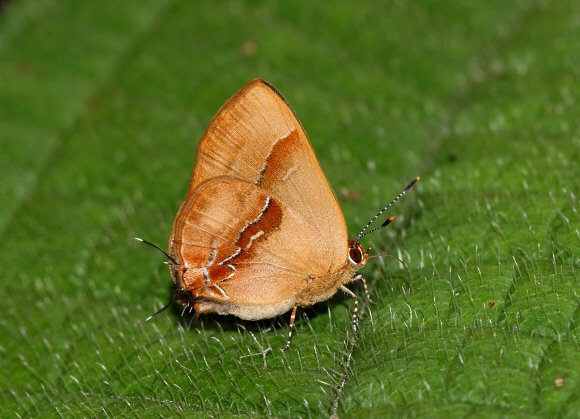
Introduction
Almost all neotropical Theclinae species are placed in the Eumaeini. The tribe is not particularly well represented in collections, so until fairly recently a high percentage remained unstudied, and were inappropriately filed away in the ‘convenience’ genus Thecla. Many taxonomists have attempted to rationalise the systematics of the Eumaeini, the most recent being Robbins who published a revision in 2004, reclassifying the taxa into 83 genera. Currently there are 1058 known species. Taking into account their small size, secretive behaviour, and the great similarities between many species, it is estimated that about another 200 species probably remain to be discovered.
The genus Calycopis comprises of 72 species, variously distributed from Mexico to Paraguay. The males of most species have metallic blue uppersides, while the females in most cases tend to be a dull earthy brown colour. Both sexes of all Calycopis species and have convex outer margins to the forewings. The undersides bear a dark post median line, and usually a short vertical line at the end of the discal cells. The hindwings have a distinctively shaped wiggly ‘hairstreak’ post-median line, and most species have either one or two black-centred red spots at the tornus. The hindwings also bear 3 short white-tipped tails.
Calycopis demonassa and its close relative buphonia are unusual because their underside wings are umber rather than the typical grey of other Calycopis species. They also lack the usual red tornal spots, and their ‘hairstreak’ lines are edged with broad brown bands as opposed to the thin red lines found on most other species. Both sexes of buphonia have dull earthy brown uppersides. Males of demonassa have blackish forwings but their hindwings are an extremely reflective iridescent violet-blue. Females of demonassa have dull brown forewings and pale silvery blue hindwings.
This species is known from Brazil and Colombia but probably also occurs in Ecuador and Venezuela.
Habitats
This species is found in rainforest and cloudforest at elevations between about 400-1600m.
Lifecycle
To be completed.
Adult behaviour
Calycopis butterflies probably spend most of their lives at or near ground level, and are popularly known as Groundstreaks. They seem to obtain all their sustenance from moisture imbibed from the ground, or from the surface of leaves.
